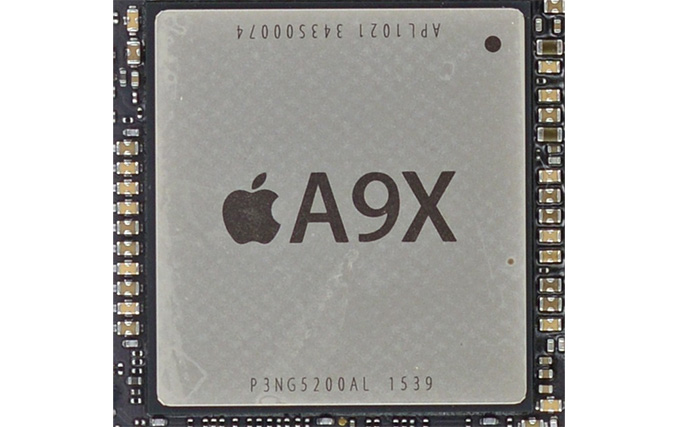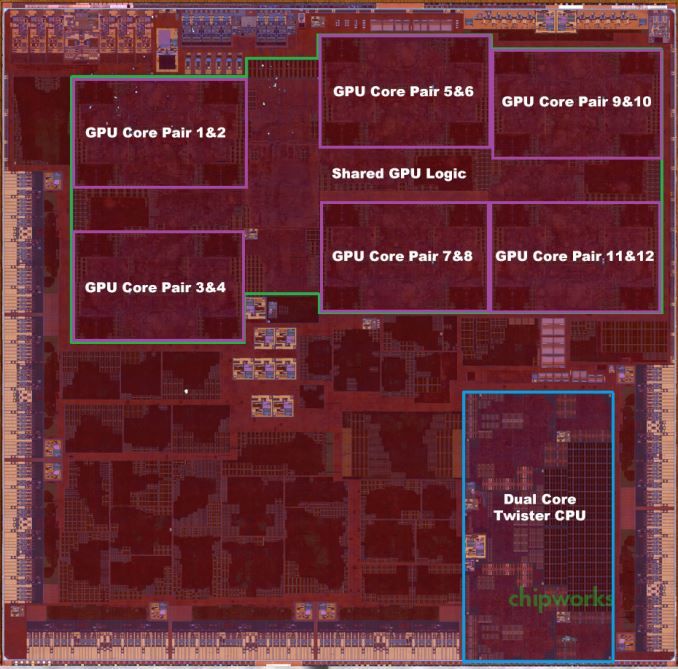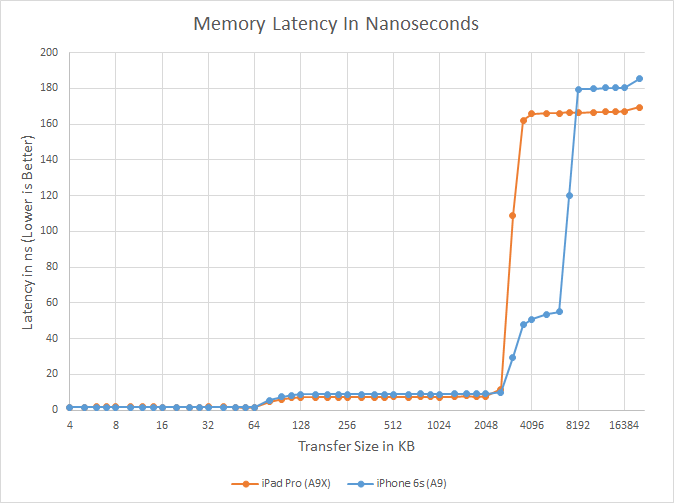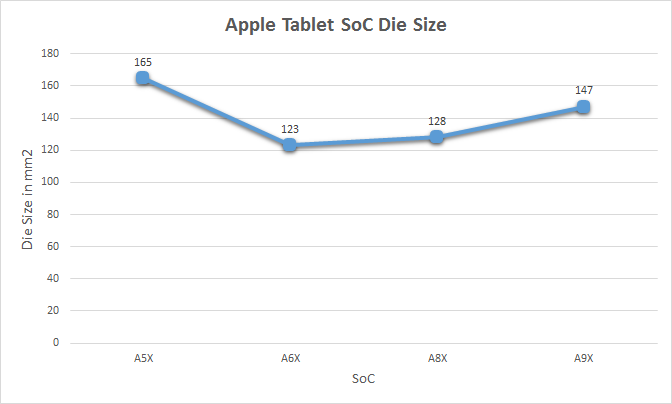The Apple iPad Pro Review
by Ryan Smith, Joshua Ho & Brandon Chester on January 22, 2016 8:10 AM ESTSoC Analysis: Apple A9X
Diving into the heart of the iPad Pro, we have Apple’s latest generation tablet SoC, A9X. Like the other Apple X series SoCs before it, A9X is by and large an enhanced and physically larger version of Apple’s latest phone SoC, taking advantage of the greater space and heat dissipation afforded by a tablet to produce a more powerful SoC.

Apple's A9X (Image Courtesy iFixit)
That Apple has developed a new SoC to launch alongside the iPad Pro is in no way surprising, but just as how the iPad Pro has ramifications for the overall iPad lineup as Apple gets into the productivity tablet market, iPad Pro’s genesis is reflected in its component selection. Apple already needed a powerful SoC for the iPad Air 2 in order to keep performance up with the tablet’s high resolution of the screen, and iPad Pro in turn pushes Apple’s performance needs even harder. Not only is there an even higher resolution screen to drive – the 2732x2048 display has about 66% of the pixels of a 4K display – but now Apple needs to deliver suitable performance for content creation and meaningful multitasking. I don’t want to imply that the A9X was somehow specifically designed from scratch for the iPad Pro, as there are a number of more important engineering considerations, but I do want to highlight how the iPad Pro is not just another iPad, and that as Apple expands the capabilities of the iPad they need to expand the performance as well if they wish to extend their reputation for smooth UX performance.
Looking at the specifications of the A9X, it seems like Apple always throws us a curveball on the X series SoCs, and for their latest SoC this is no different. With A8X Apple delivered more RAM on a wider memory bus, a larger GPU, and surprisingly, three Typhoon CPU cores. To date it’s still not clear just why Apple went with three CPU cores on A8X – was it for multitasking, or as an alternative means to boost performance – and A9X’s configuration only serves to highlight this enigma.
| Apple SoC Comparison | ||||||
| A9X | A9 | A8X | A6X | |||
| CPU | 2x Twister | 2x Twister | 3x Typhoon | 2x Swift | ||
| CPU Clockspeed | 2.26GHz | 1.85GHz | 1.5GHz | 1.3GHz | ||
| GPU | PVR 12 Cluster Series7XT | PVR 6 Cluster Series7 (PVR GT7600) |
PVR 8 Cluster Series6XT (APL GXA6850) |
PVR SGX554 MP4 | ||
| RAM | 4GB LPDDR4 | 2GB LPDDR4 | 2GB LPDDR3 | 1GB LPDDR2 | ||
| Memory Bus Width | 128-bit | 64-bit | 128-bit | 128-bit | ||
| Memory Bandwidth | 51.2GB/sec | 25.6GB/sec | 25.6GB/sec | 17.1GB/sec | ||
| L2 Cache | 3MB | 3MB | 2MB | 1MB | ||
| L3 Cache | None | 4MB | 4MB | N/A | ||
| Manufacturing Process | TSMC 16nm FinFET | TSMC 16nm & Samsung 14nm |
TSMC 20nm | Samsung 32nm | ||
Instead of continuing with a triple-core CPU design for A9X, for their latest X series SoC Apple has dropped back down to just a pair of Twister CPU cores. The catch here – and why two cores is in many ways better than three – is that relative to A8X and A9, Apple has cranked up their CPU clockspeeds. Way, way up. Whereas the iPad Air 2 (A8X) shipped at 1.5GHz and the iPhone 6s (A9) at 1.85GHz, the A9X sees Apple push their clockspeed to 2.26GHz. Not counting the architectural changes, this is 22% higher clocked than the A9 and 51% higher than the A8X.
The fact that Apple dropped back down to 2 CPU cores is unexpected given that we don’t expect Apple to ever go backwards in such a fashion, and while we’ll never know the official reason for everything Apple does, in retrospect I’m starting to think that A8X was an anomaly and Apple didn’t really want a tri-core CPU in the first place. A8X came at a time where Apple was bound by TSMC’s 20nm process and couldn’t drive up their clockspeeds without vastly increasing power consumption, so a third core was a far more power effective option.

A9X Die Shot w/AT Annotations (Die Shot Courtesy Chipworks)
Overall this means that iPad Pro and A9X will set a very high bar for tablet CPU performance. As we’ve already seen in the iPhone 6s review, the Twister CPU core is very potent and in most cases faster than any other ARM CPU core by leaps and bounds. Cranking up the clockspeed a further 22% only serves to open up that gap even further, as Twister is now reaching clockspeeds similar to the likes of Cortex-A57 and A72, but with its much wider execution pipeline and greater IPC. This is also the reason that an Intel Core CPU comparison is so interesting, as Intel’s tablet-class Core processors in many ways are the target to beat on overall CPU performance, and we’ll be touching upon this subject in greater detail a bit later.
GPU: Imagination PowerVR 12 Cluster Series 7XT
Meanwhile on the GPU side, as expected Apple has further increased the number of clusters on their SoC to drive the higher resolution display of a tablet. Whereas A9 used a 6 cluster design (PVR GT7600), A9X doubles this, giving us a relatively massive 12 cluster design.
In Imagination’s PowerVR Series7XT roadmap, the company doesn’t have an official name for a 12 cluster configuration, as this falls between the 8 cluster GT7800 and 16 cluster GT7900. So for the moment I’m simply calling it a “PowerVR 12 cluster Series7XT design,” and with any luck Imagination will use a more fine-grained naming scheme for future generations of PowerVR graphics.
In any case, the use of a 12 cluster design is a bit surprising from an engineering standpoint since it means that Apple was willing to take the die space hit to implement additional GPU clusters, despite the impact this would have on chip yields and costs. If anything, with the larger thermal capacity and battery of the iPad Pro, I had expected Apple to use higher GPU clockspeeds (and eat the power cost) in order to save on chip costs. Instead what we’re seeing is a GPU that essentially offers twice the GPU power of A9’s GPU.
However to put all of this in context, keep in mind that iPad Pro’s display is 5.95Mpixels, versus the 2.07Mpixel screen on the iPhone 6s Plus. So although Apple has doubled the number of GPU clusters for A9X – and I suspect clocked it fairly similarly – that increased performance will be very quickly consumed by the iPad Pro’s high resolution screen. Consequently even a 12 cluster GPU design is something of a compromise; if Apple wanted to maintain the same level of GPU performance per pixel as in the iPhone 6s family, they would have needed an even more powerful GPU. Which just goes to show how demanding tablets can be.
Memory Subsystem: 128-bit LPDDR4-3200, No L3 Cache
Responsibility for feeding the beast that is A9X’s GPU falls to A9X’s 128-bit LPDDR4 memory controller configuration. With twice as many GPU clusters, Apple needs twice as much memory bandwidth to maintain the same bandwidth-to-core ratio, so like the past X-series tablet SoCs, A9X implements a 128-bit bus. For Apple this means they now have a sizable 51.2GB/sec of memory bandwidth to play with. For an SoC this is a huge amount of bandwidth, but at the same time it’s quickly going to be consumed by those 12 GPU clusters.
| Geekbench 3 Memory Bandwidth Comparison (1 thread) | ||||||
| Stream Copy | Stream Scale | Stream Add | Stream Triad | |||
| Apple A9X 2.26GHz | 20.8 GB/s | 15.0 GB/s | 15.3 GB/s | 15.1 GB/s | ||
| Apple A8X 1.5GHz | 14.2 GB/s | 7.44 GB/s | 7.54 GB/s | 7.49 GB/s | ||
| A9X Advantage | 46.4% | 101% | 103% | 102% | ||
It’s also while looking at A9X’s memory subsystem however that we find our second and final curveball for A9X: the L3 cache. Or rather, the lack thereof. For multiple generations now Apple has used an L3 cache on both their phone and tablet SoCs to help feed both the CPU and GPU, as even a fast memory bus can’t keep up with a low latency local cache. Even as recent as A9, Apple included a 4MB victim cache. However for A9X there is no L3 cache; the only caches on the chip are the individual L1 and L2 caches for the CPU and GPU, along with some even smaller amounts for cache for various other functional blocks..
The big question right now is why Apple would do this. Our traditional wisdom here is that the L3 cache was put in place to service both the CPU and GPU, but especially the GPU. Graphics rendering is a memory bandwidth-intensive operation, and as Apple has consistently been well ahead of many of the other ARM SoC designers in GPU performance, they have been running headlong into the performance limitations imposed by narrow mobile memory interfaces. An L3 cache, in turn, would alleviate some of that memory pressure and keep both CPU and GPU performance up.
One explanation may be that Apple deemed the L3 cache no longer necessary with the A9X’s 128-bit LPDDR4 memory bus; that 51.2GB/sec of bandwidth meant that they no longer needed the cache to avoid GPU stalls. However while the use of LPDDR4 may be a factor, Apple’s ratio of bandwidth-to-GPU cores of roughly 4.26GB/sec-to-1 core is identical to A9’s, which does have an L3 cache. With A9X being a larger A9 in so many ways, this alone isn’t the whole story.
What’s especially curious is that the L3 cache on the A9 wasn’t costing Apple much in the way of space. Chipworks puts the size of A9’s 4MB L3 cache block at a puny ~4.5 mm2, which is just 3% the size of A9X. So although there is a cost to adding L3 cache, unless there are issues we can’t see even with a die shot (e.g. routing), Apple didn’t save much by getting rid of the L3 cache.
Our own Andrei Frumusanu suspects that it may be a power matter, and that Apple was using the L3 cache to save on power-expensive memory operations on the A9. With A9X however, it’s a tablet SoC that doesn’t face the same power restrictions, and as a result doesn’t need a power-saving cache. This would be coupled with the fact that with double the GPU cores, there would be a lot more pressure on just a 4MB cache versus the pressure created by A9, which in turn may drive the need for a larger cache and ultimately an even larger die size.
As it stands there’s no one obvious reason, and it’s likely that all 3 factors – die size, LPDDR4, and power needs – all played a part here, with only those within the halls of One Infinite Loop knowing for sure. However I will add that since Apple has removed the L3 cache, the GPU L2 cache must be sizable. Imagination’s tile based deferred rendering technology needs an on-chip cache to hold tiles in to work on, and while they don’t need an entire frame’s worth of cache (which on iPad Pro would be over 21MB), they do need enough cache to hold a single tile. It’s much harder to estimate GPU L2 cache size from a die shot (especially with Apple’s asymmetrical design), but I wouldn’t be surprised of A9X’s GPU L2 cache is greater than A9’s or A8X’s.
Building A9X Big: 147mm2, Manufactured By TSMC
Finally, let’s talk about the construction and fabrication of the A9X SoC itself. Chipworks’ previous analysis shows that the A9X is roughly 147mm2 in die size, and that it’s manufactured by TSMC on their 16nm FinFET process.
At 147mm2 the A9X is the second-largest of Apple’s X-series tablet SoCs. Only the A5X, the first such SoC, was larger. Fittingly, it was also built relative to Apple’s equally large A5 phone SoC. With only 3 previous tablet SoCs to use as a point of comparison I’m not sure there’s really a sweet spot we can say that Apple likes to stick to, but after two generations of SoCs in the 120mm2 to 130mm2 range, A9X is noticeably larger.
Some of that comes from the fact that A9 itself is a bit larger than normal – the TSMC version is 104.5mm2 – but Apple has also clearly added a fair bit to the SoC. The wildcard here is what yields look like for Apple, as that would tell us a lot about whether a 147mm2 A9X is just a large part or if Apple has taken a greater amount of risk than usual here.
A9X continues to be the largest 16nm FinFET ASIC we know to be in mass production at TSMC (we’ll ignore FPGAs for now), and while this will undoubtedly change a bit later this year once the next-generation discrete GPUs come online, I don’t think you’ll find a better example of how the contract chip manufacturing market has changed in a single generation. 4 years ago it would be GPUs leading the charge, but now it’s phone SoCs and a rather sizable tablet SoC that are first out of the gate. After almost a decade of catching up, SoCs have now reached the bleeding edge for chip fabrication, enabling rapid performance growth, but also inheriting the risks of being the leader. I won’t dwell on this too much, but I’m immensely curious about both what A9X yields are like as the largest FinFET ASIC at TSMC, and just how much of TSMC’s FinFET capacity Apple has been consuming with the production of A9 and A9X.
Finally, it's also interesting to note just how large A9X is compared to other high performance processors. Intel's latest-generation Skylake processors measure in at ~99mm2 for the 2 core GT2 configuration (Skylake-Y 2+2), and even the 4 core desktop GT2 configuration (Intel Skylake-K 4+2) is only 122mm2. So A9X is larger than either of these CPU cores, though admittedly as a whole SoC A9X contains a number of functional units either not present on Skylake or on Skylake's Platform Controller Hub (PCH). Still, this is the first time that we've seen an Apple launch a tablet SoC larger than an Intel 4 core desktop CPU.













408 Comments
View All Comments
MaxIT - Saturday, February 13, 2016 - link
There is one reason for that: most PCs are just cheap computers compared to Macsddriver - Sunday, January 24, 2016 - link
"90% of the professional software development studios I work with are almost solely Mac based"That has got to do with the urban legend, begot during the time of apple's pathetic "mac is cool, pc is for dorks" ad campaigns. Ignorant people with no tech knowledge genuinely believe the macs are a good deal. And while the hardware is OK, it offers too little value for the cost, software is... meh... more professional grade products run on windows than on macos. There aren't any notable macos exclusives, there are some professional products which do not support macos.
The ipad "pro" software wise doesn't offer anything on top of the regular ipad, the same cheap, crippled, rudimentary applications. It is a little bigger and has a pen with the world's lamest charging implementation, that's about it.
There is no software for the ipad a professional musician or produced could use, the apps which exist for that platform and light years behind the professional software you can run on a windows tablet. None of the professional DAWs, editors, synthesizers, effects or samplers are available for the ipad. Usually the companies which make such professional products have offer very basic and very scaled down versions of their flagship products, far below the requirements of professionals, really only suited for amateur beginners.
That pretty much sums the ipad "pro" - it is a product for "professional" amateurs :)
iOS is a walled garden, apparently, because apple deems its "smart user base" too dumm to deserve freedom and flexibility. And professional apps need that much as professional users do. Even if there are professional apps, they sure as hell won't be available on the apple store, and would require to root your device and void its warranty so it can be used.
"but everyone who thinks that the surface pro 4 is even remotely in the same category of device, is utterly smoking crack"
DO'H, of course they are not, the surface pro is a real professional computer inside a tablet, the ipad is a hipster/child toy inside a tablet.
Constructor - Sunday, January 24, 2016 - link
This is exactly the same type of argumentation that tried to "prove" that personal computers had to be "useless toys" – no, that graphical user interfaces were only for "useless toys" – no, that those silly laptop computers could only be "useless toys" – no, that touchscreen smartphones without hardware keyboards could only be "useless toys"...And now, after all these prior predictions have already crashed and burned, tablets are your last and only remaining hope that your oversimplified conclusions from your own preconceived notions might maybe not share the same fate.
Good luck with that! B-)
darwiniandude - Monday, February 29, 2016 - link
iOS and OS X are low latency end to end, with built in audio hardware. Windows is not. iPhone 5s, iPad Air1, iPad mini 2, onwards, can record from 32 simultaneous inputs onto separate tracks with ease till their disk is full. And it's 100% solid. There is much capable and professionally usable iOS music software. And robust plugin and Interapp audio communication logins.jlabelle - Thursday, January 28, 2016 - link
"the surface pro 4 (a mildly crappy laptop with a touchscreen that makes a bad, thick tablet and an underpowered, overheated laptop)"Strange way of seeing things when the surface Pro 4 is pretty much : 1/ the thinner laptop existing
2/ the higher end version is like several order of magnitude more powerful than the MacBook and 3/ it has the same Intel processor as most over high end laptop and overheat the same way and it has an option of having a fanless / staying cold core M if this is your thing
darwiniandude - Monday, February 29, 2016 - link
Music applications iOS is the only game in town. Windows doesn't have low latency except if you use external audio hardware. Many PC notebooks even then cannot achieve low latency due to design flaws. A client recently bought an AUD$3500 Alienware purely for running Tracktor. Spent 6 months trying everything including reverting to Win7. It just crackles and jumps. I worked in the music industry building audio PCs for 8 years and I had a look over the system and tried everything. No dice. I told him it won't work. He bought an AUD$2500 MacBook Pro, installed Tracktor, works faultlessly. Of course.The issue here is more the Alienware craptop where audio is no priority at all, than Windows. Windows has the horrible burden of trying to support every combination of everything. I know this. But for some professional allocations there is no way I'd ever run a Windows system anymore.
Look at anyone performing live with music. It's all Mac / iOS. The sound engineer guys will use a PC laptop because of the old editor utilities for audio equipment needing RS232 etc, but the music you hear is coming off Apple gear.
leemond - Thursday, February 11, 2016 - link
you took the words right out of my mouth! throughout reading this article i cannot fail to see the thinly veiled adoration for Apple held by the author and it is telling in the way he wields the pseudo negatives statements against the product. i was expecting an unbiased fair appraisal of this product but what i got was the Apple store salesman dressed up as an annnandtech reviewer. This product is simply two things the original iPad is not, 1) bigger and 2) has a pencil....not revolutionary and also not that impressive a feat....apple have lost the wow factor that won them so many new customers and they only have these fanboys left to applaud fanatically like a north Korean Army officer listening to KJU..Constructor - Friday, February 12, 2016 - link
Your own post positively reeks of a fanaticism which is simply absent in the article outside of what you're projecting into it from yourself.Major and remarkable features are:
• A highly advanced CPU which has effectively closed the gap to Intel's Core i architecture at comparable TDP.
• The Pencil which is at the very least among the best on the market.
• A crazy-good speaker system for its size class which actually makes listening to music or watching movies enjoyable.
Beyond that, yes, it is "just" a bigger, faster, better iPad, but as long as you're not looking for an awkward hybrid device, that's actually a plus.
jlabelle - Thursday, January 28, 2016 - link
It is utterly non sense. W10 is not more or less "insecure loaded-with-spyware-at-the-factory desktop OS" as OS X.If you want to have the same "secure" experience as an iOS tablet, just install only applications from the Windows Store and it will be the same. If you want to use more powerful program or software that do not exist in the Store, you must like OS X take care of installing them from a reputable source. Nothing complicated.
Also, this is also utterly ridicule to claim that there are no good Windows Store app. There was examples given on the previous pages. There are plenty and you know that. You have ven some which are still quite unique like Polarr or DrawboardPDF.
I know Apple users have a hard time (and the reviewer as well) understanding that having an Apple tablet and an Apple laptop OS is even more a Frankenstein experience than having only ONE OS with ONE UI, able to run ALL type of applications and able to support ALL type of inputs so you can choose what is best for the task at end.
People consider that EVERY tasks that you have to do with a tablet is best without keyboard or mouse or pen. This is simply not true. Typing a long text with the on-screen keyboard is an exercise in frustration.
Also people consider that EVERY task on a laptop is best without touchscreen or pen. This is also wrong. Annoting a PDF, surfing the web, manipulation by hand an object of a webpage is much easier with touch or pen.
Having to go back and forth between 2 different devices that have silos input method IS what is a Frankenstein experience in my view.
And last point, the Surface has provided a "paper and pencil" experience since 3 years, much prior Apple and is still providing a top notch experience, with a pen autonomy of more than 1 year, interchangeable tip and great performance.
MaxIT - Saturday, February 13, 2016 - link
Wrong because you said so ?Surface are just half baked solutions to a non existent problem. There are tasks where I require a tablet and tasks where I require a notebook. I don't want an half baked solution not good as a tablet nor good as a notebook....